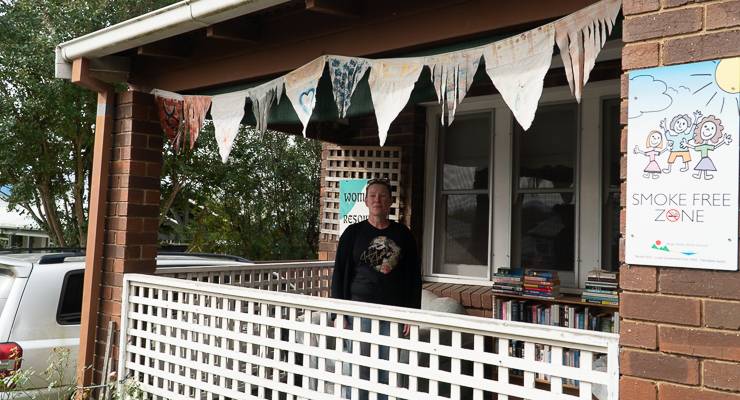
If it weren’t for a bright sign, free library and women trailing in and out of its doors, the Women’s Resource Centre in Bega would look like any other house on its street. Located in the marginal electorate of Eden-Monaro — where Labor is holding on to the seat by a thread — the centre provides services to women facing homelessness, fleeing domestic violence, or who are in precarious situations, with no questions asked of whoever uses its services.
But the centre is struggling, organiser Jane Hughes tells Crikey, largely thanks to the housing crisis plaguing the region. In the 2020 byelection, the centre conducted a local social media survey on which issues mattered most — with housing high up on that list.
Nearly half of all Bega’s residents are aged over 55, the 2016 census found. Locals have a median weekly household income of $986 compared to $1,486 across the state.
Renting is expensive: the median weekly rent is between $20 to $50 higher in the Bega Valley Shire than in the rest of NSW, excluding Sydney. There’s a 10-year waitlist for some properties, with a vacancy rate of just 0.5%. The issue has been made worse by the Black Summer bushfires, which razed many towns in the regions, while COVID-19 lockdowns hampered rebuilding efforts.
The residents in Bega aren’t alone in their housing struggles. Many areas — many marginal areas — are struggling with housing affordability, rental vacancies and homelessness. Across regional Australia, home prices have increased by nearly 20% — with rental prices soaring to more than 11% in the past financial year as COVID-19 caused city slickers to move out to more open spaces.
The pinch is being felt across a number of marginal electorates, including Gilmore and Eden-Monaro in NSW, Bass in Tasmania and Flinders in Victoria. Yet neither major party has addressed rental vacancies and affordability, focusing more on helping first-time homeowners enter the market.
Homelessness is seen as a ‘minority’ issue
On 2016 census night, more than 116,000 Australians were experiencing homelessness — a huge number that affects not just those experiencing homelessness, but their families and social circles. Those most at risk are pensioners who don’t own their own homes, young people, Aboriginal and Torres Strait Islander peoples and older women.
First Nations peoples make up around a quarter of those who are homeless or at risk of homelessness, with 75% of those living in severely crowded housing. Four in 10 Indigenous homeless people were aged 18 or under, with the majority living in very remote areas.
Women aged over 55 are the fastest-growing cohort of homeless Australians — and both are growing issues, UniSA Business Executive Dean Professor Andrew Beer tells Crikey.
“It has become a very prominent issue … to a certain extent, that issue really speaks to a broader discontent of women with how they’ve been treated within the current political and economic system,” he said.
But just because discontent is growing, that doesn’t mean the government is listening, and homelessness rarely features prominently in political campaigns.
“[The number of homeless Australians] is not large compared to the total population of Australia so it’s not a majority [political] issue — it’s a minority issue,” Beer said.
What’s being done about it?
Homelessness has been a long-standing issue for decades, Grattan Institute Economic Policy Program Director Brendan Coates tells Crikey, with the federal government reluctant to take drastic action.
“There are plenty of things the federal government could do to solve this broader problem, but they involve basically pushing the states to build more housing by relaxing planning rules — basically paying the states to do planning reform,” he said.
With young people increasingly at risk of homelessness, the current two parties’ policies just don’t cut it: Labor has its “Help to Buy” scheme purchasing up to 40% of a home in a shared equity scheme, along with using investment returns to build social and affordable housing. The Coalition has proposed allowing first-home buyers to use their superannuation to buy a home, and helping homeowners aged over 55 to downsize.
Both policies have been criticised as lacking ambition — and, as Coates says, don’t do enough to address at-risk cohorts. With young people at risk of homelessness, more are relying on their parents for support — meaning downsizing isn’t an option for many families.
“People tend to not be able to find the kind of housing they want to downsize to in their suburb — in some cases, ironically, because they’ve spent they’ve spent the last 40 years opposing that kind of housing being built in the community.”
Older people, he said, couldn’t use their superannuation to buy a house because they don’t have enough income for a mortgage (though Labor’s shared equity scheme would help).
Crying out for assistance
Back in Bega, Hughes said residents were crying out for help. “We lack accommodation and a lack of builders and materials … so we really need the government to come in and fund things,” she said.
Some women, she said, were choosing to stay in violent relationships rather than face homelessness. “I’ve seen a lot of talk and a lot of announcements, a lot of re-announcing money that was already announced, but not a lot of real action,” she said.
Along with lacking construction workers and supplies, a major issue was those from the cities moving in and buying property, further driving up rental prices. Community members had sold their homes during peak highs while others had bought investment properties or moved in while working remote and ordering online — meaning not a lot of money was going back into the community, she said, and a lot of the jobs that needed to be filled were staying vacant.
“It’s just this really complex set of circumstances.”








Sorry Amber but the two major parties’ main aim is to stay in power . They look at collecting votes to stay in power .This is the time their true colors show . Unless you are part of a large voting group go to the back of the queue.The last group to be favored is the minority. Depending on the media’s ability to extract tears from the larger groups, the battlers may be lucky enough to collect enough crumbs to live from week to week .
Society should be judged by how it treats its minority groups. Ours does not give a stuff
Homeless in a Australia. Talk about government abandoning its duty to its citizens, made worse when (COVID aside) our government has maintained the highest per capita immigration rate in the world and elevated Property to become Australia’s biggest single industry, bigger than Mining and Agriculture. Its just wrong at so many levels. A disgraceful failure that must be rectified.
Such rectification would need at least 10-15M brain transplants for the electorate.
Not sure of a source for an adequate supply of donors but at least those removed could be sold off as ‘unused, like new‘.
You have missed the ALP’s policy of setting up a $10 billion fund, whose earnings are expected to build 20 thousand social housing residences over 5 years, including 4000 for women and children escaping domestic violence and older women on low incomes and 10,000 over 5 years for police, nurse and essential workers so they can live closer to where they work. Whether this policy will work is not entirely clear before an attempt to make it work is made but, if the commitment is genuine, you could expect necessary adjustments to make it work.
20,000 affordable homes when demand is in the hundreds of thousands. 4000 social houses equates to just a couple of homes in every village, town and city in the nation!, when there’s already a waiting list of over ten years in everyone of those towns. It’s just another example of Labor tinkering around the edges instead of getting serious.
I love when you say “Whether this policy will work is not entirely clear…” Actually it is clear. It won’t work. 20,000 social housing residencies and this over longer than the forward estimates and 10,000 for essential workers. What worker is not essential. Don’t answer that. Used car salesmen. Uber drivers. Fast food delivery riders. Personal services – need I go there?
This is really a low bar to set. 30,000 residences for the “deserving”. The demand is far in excess of this. We are in the classic bind. Home prices need to fall dramatically for people to afford them who currently cannot. And if this happens this will usher in if not epitomise a Depression – forget recession. We are in one really if not technically.
Check out Community Land Trusts see macll.org.au
There is going to be a huge influx of aged homeless in the next few years. And still nothing will change. Our politicians are far happier paying home and investment owners more money in terms of franking credits and negative gearing than a renter will ever see for a decent house.
You didn’t mention negative gearing and the capital gains discount which makes it easier for investors to buy properties than first home buyers. I have a niece with two children in a country town in Eden-Monaro. Much of the housing is being bought up by Sydney investors which provides only insecure rentals and also prices the locals out if buying a home. In my niece’s case, and it is often the only hope for young people, the bank of Mum and possibly aunt will help her buy a modest place as she’d have no hope on her own. If there are no older relatives to help, young people are destined for insecure accommodation possibly for the rest of their days. And that is also the case in the city.
Hear Hear. Government policies that advantage property investors over would be HOME owners. But when a majority of politicians enjoy emerging wealth from their own property investing why should we be surprised about such policies. Absolutely disgraceful where the ONLY way to rectify the issue is vote the offenders out – LNP and ALP.
Yes agree.
Vote Community supported Independents.